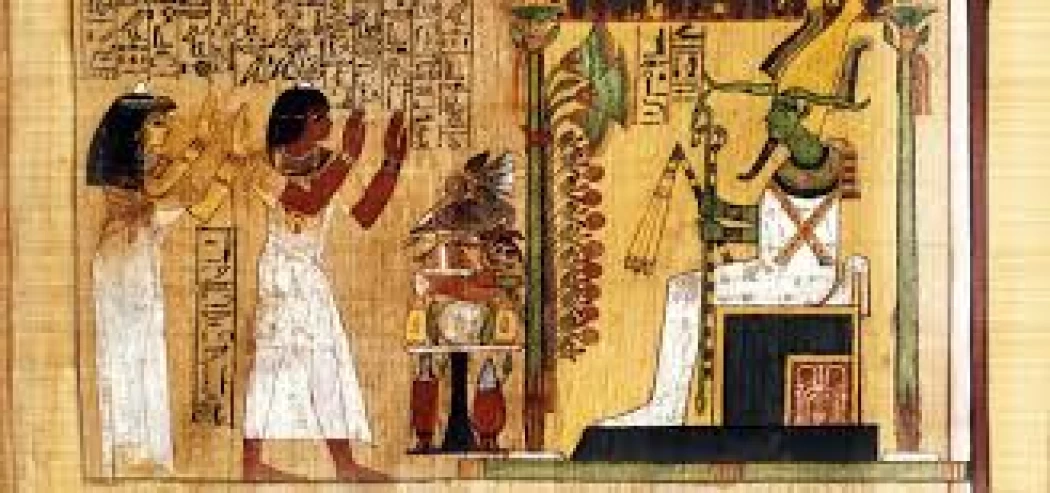
亡灵书》 | 古埃及殡葬文本
里面有各种各样的陪葬文本,包括magico-religious公式和故事,借助这些公式,死者可以克服他在漫长而曲折的道路上面临的无数考验,这些道路导致他出现Osiris。 因此,这些经文将帮助他在没有任何特殊问题的情况下到达死亡之神,并准备他尘世生活的所谓证词,其审判属于奥西里斯。
随着时间的推移,死亡之书采取了各种形式。 最初,确实,公式和故事被刻在坟墓的墙壁上,只是直接刻在石棺上。 随着时间的推移,直到第十八王朝(公元前1543-1292年),死者之书再次改变了它的形式:葬礼文本被转移到纸莎草纸,然后与死者以及所有可能在他最后旅程中
这些神奇的公式放置在坟墓,根据信仰,保护和帮助死者在冥界,他们包括赞美诗神阿蒙Re,太阳神。 我们可以在墓穴的通道和墙壁上,木乃伊的包装上,甚至在图坦卡蒙国王的金色面具内看到咒语的描述。
死亡之书最早出现在新王国,但它的文本是从一个漫长的魔法葬礼写作历史演变而来的。 其中最古老的金字塔文本只有埃及人可以访问。 然后他们演变为棺材文本-金字塔文本的修改版本-这些文本写在棺材上,并包含在非皇室成员的坟墓中,例如富有的埃及人和精英的代表。
奥西里斯是复活之神,雷是太阳神,是亡者之书中的一颗星。 然后42个额外的神转向法官。 虽然文本本身在内容和顺序上有所不同,但故事通常分为四个主要部分:死者进入冥界并重新获得生者的身体力量,死者复活并加入Re,每天像太阳一样升起,他在众神的冥界审判之前穿越天空,最后找到一个灵魂。
前往埃及参观埃及的寺庙和金字塔,了解更多关于神话和法老所崇拜的数百位神,他们与人类非常相似,他们爱和恨,感到嫉妒,战斗和死亡,这是一个充满欢乐,活跃和戏剧性事件的惊人神话,激发了现代电影制片人和制片人创造世界着名的关于法老和他们所崇拜的神的伟大的电影。 留出几天时间参观阿比多斯,吉萨,卢克索,阿斯旺,看看法老的坟墓装饰着非常清晰,详细和美丽的古埃及各种神灵的场景,以及许多其他地方,城市,冒险和:
-旅游路线在埃及|路线在埃及。
-游览阿斯旺/游览阿斯旺/一日游阿斯旺/观光游览阿斯旺。
Inside were funerary texts of various kinds, both magico-religious formulas and stories, with the help of which the deceased could overcome the countless trials that he would face on the long and winding path that led him to the presence of Osiris. The texts, therefore, would have helped him both to reach the god of death without any special problems, and to prepare the so-called testimony of his earthly life, the trial of which belonged to Osiris.
The Book of the Dead has taken various forms over time. Initially, indeed, formulas and stories were engraved on the walls of the tomb, only to be engraved directly on the sarcophagus. Over time and until the eighteenth dynasty (1543-1292 BC), the book of the dead changed its form again: the funeral texts were transferred to papyrus, then closed in a sarcophagus along with the deceased and all those objects that could be useful in his last journey.
These magical formulas placed in tombs, according to beliefs, protected and helped the deceased in the underworld, and they include hymns to the god Amun Re, the god of the sun. We can see descriptions of spells on the passages and walls of tombs, on the wrappers of mummies and even inside the golden mask of King Tutankhamun.
The Book of the Dead first appeared in the New Kingdom, but its text evolved from a long history of magical funeral writing. The most ancient of them, the Pyramid Texts, were accessible only to the Egyptians. Then they evolved to Coffin Texts - a modified version of the Pyramid Texts - which were written on coffins and included in the tombs of non-royal persons, such as rich Egyptians and representatives of the elite.
As for the history of the writing of the Book of the Dead, the Pharaohs wrote down the Book of the Dead during the era of the construction of the Great Pyramid, and a copy of it is still preserved in the British Museum. It contains invocations to the gods, hymns, and prayers. Then there is a description of the reckoning that the souls of the dead encounter in the afterlife and the punishment and reward that befalls them.
The Pharaohs built huge temples in addition to tombs that were no less magnificent and luxurious, as they believed in resurrection and the return of the soul, which they depicted in two close images, "Ka" or "Ba." They were also keen to place all the things related to the deceased, including food, jewelry, and everything he loved in his life, with him in his tomb, where the soul of the deceased could eat and drink from it when it returned to the body, and before seeking the afterlife.
The ancient Egyptians knew religious literature since the dawn of history, and their holy books varied, most of which were about death and the afterlife. Their books usually contained a group of religious texts that expressed the Egyptians' perception of the life of the dead in the afterlife, and included a group of spells that were recited when preparing the body for burial.
Perhaps the ancient Pharaohs amazed the world with the diversity of these texts, and their abundance of ancient religious spells and literature, which remained an icon no less important than the remaining monuments from the Pharaonic eras, such as temples, royal tombs, and obelisks. Among these books' most significant works are:
Book of the Dead
Pyramid texts
The Book of Two Paths
The Guide's Book
Spell No. 125 is one of the most famous texts of the Book of the Dead. Even those unfamiliar with the book, and those unfamiliar with Egyptian mythology, know about the spell without realizing it. It is the incantation describing the trial of the deceased's heart in the Hall of Justice by the god Osiris, and is one of the most famous known images from ancient Egypt, although the god with his scale is not actually described in the text. Given the importance of the deceased passing the test of his heart weight in order to pass into bliss, knowing what to say and how to act in the presence of Osiris, Thoth, Anubis and the forty-two judges was the most important information with which the deceased could reach the afterlife.
After death, Anubis guides the deceased to the Hall of Justice (also known as the Hall of Two Truths), where the deceased will make the Confession of Absolution (also known as the Declaration of Innocence). This Confession of Absolution was a list of forty-two sins that the individual could honestly deny never to commit. Once made, Osiris, Thoth, Anubis, and the Forty-Two Judges consulted.
If the confession was accepted, the deceased's heart was weighed in a balance against the white feather of Maat, the feather of truth. If the deceased's heart was lighter than the feather of Maat, their soul passed to Heaven; if it was heavier than the feather, the heart was thrown to the ground, where it was devoured by the divine monster Ammut, and its owner's soul ceased to exist.
Spell 125 begins with an introduction to the reader (i.e., the soul of the deceased): "What to say upon arrival at the Hall of Justice"














